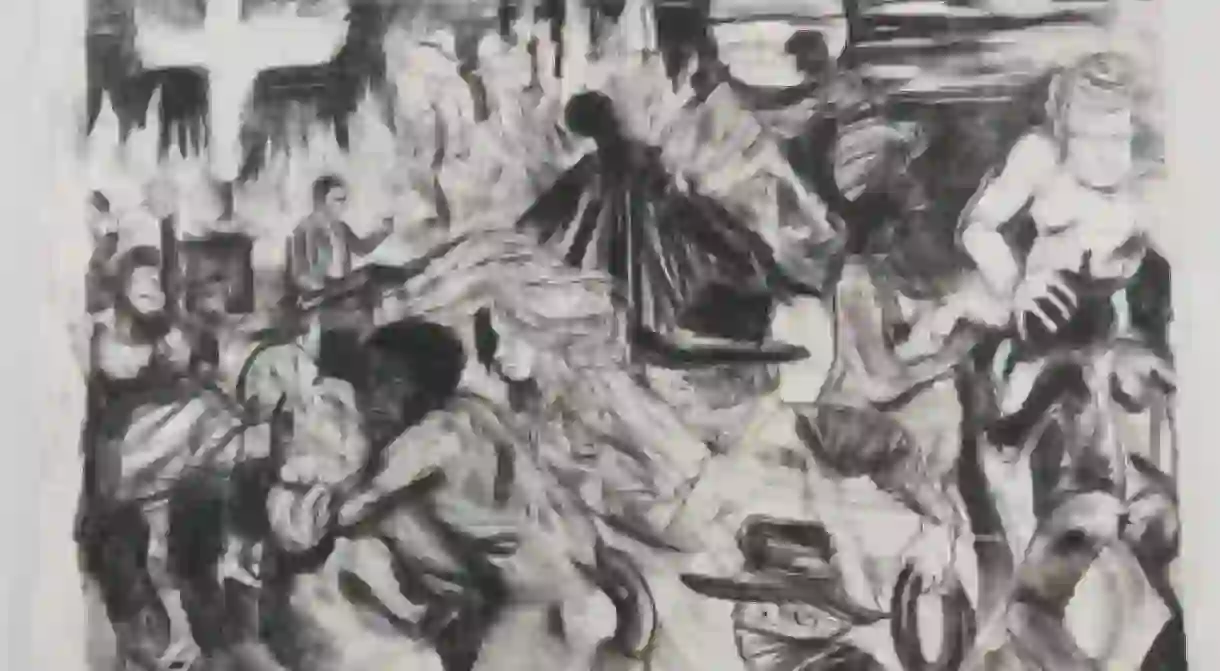Kara Walker: Theatrics Of Power

The signature black cut paper silhouettes of artist Kara Walker address the contentious topics of race, gender and sexuality. Michèle Kieffer explores the motivation behind the work of this controversial yet significant contemporary artist.

At the end of last year, a drawing by Kara Walker caused quite a controversy, when employees of a New Jersey library covered it up for several months. Carrying the more than descriptive title The moral arc of history ideally bends towards justice but just as soon as not curves back around toward barbarism, sadism, and unrestrained chaos (2010), the artwork represents an imaginary collage of numerous episodes, likely to be set in the antebellum South of the US. A burning cross, violence and particularly the interracial oral sex scene shocked visitors and employees alike, especially the African-American community, according to the library. Kara Walker, an African-American woman herself addressed the issue through her gallery: ‘The work is not about slavery so much as it conjures horrors of reconstruction and 20th-century Jim Crow-ism and the Tea Party. I wanted to make a point about the way these images arose for many when Barack Obama (pictured at a little lectern on the mid-left) gave his national speech on race. (…)’.

It is not the first time that Walker’s work has provoked a discourse. This is certainly due to the fact that the artist expresses herself through rather rough imagery which could easily be interpreted as disrespectful or offensive. Born in California in 1969, Walker is best known for her black cut-paper silhouettes stuck directly to the wall. She started developing the technique in 1993, while still a student at the Rhode Island School of Design. Walker doesn’t shy away from controversial topics such as race, gender and sexuality, and the development of discussions surrounding these topics through the years. Like her provocative drawings, most of her work focuses on African American history in general and on slavery in particular. Walker represents these topics through her unique view, mixing historical facts and fantastical aspects. The life-sized shapes combine the technique of the popular 18th century shadow portraits, the drama of traditional fairy tales, the irony and cheekiness of comic books, as well as the harsh aspects of the real world and its loaded history. The modern murals are an accumulation of individual scenes, readable as a whole or as unique segments; it can be difficult to set them in time and space. The artist plays with racist archetypes and uses them as a tool to criticise racial and gender stereotypes as well as historical narratives.

At first sight Walker’s artworks can seam randomly composed, but rather they are highly thought-out narratives, as object has its specific place and meaning. The artist explains herself extensively through her website, created for her biggest exhibition yet: Kara Walker: My Complement, My Enemy, My Oppressor, My Love. This might seam odd for an established contemporary artist like Walker, but considering the storm of protest she has caused over the years, the existence of the site is comprehensible. However, the homepage proves that Walker is much more than a misinterpreted artist. Not only does it set her thoughts and motives in context, but it lays out the research behind the artist’s theatrical world. The site also features a lexicon, explaining recurring themes to the public. One interesting example relates to the omnipresence of violence, which the artist justifies through comparison with the long tradition of brutality in Western art: crucifixion, capitation, etc.
Since her first exhibition in 1994, Kara Walker has gained international recognition. She was named as one of Time’s most influential people in 2007 and has shown work at the Walker Art Center, the Musée d’Art moderne de la Ville de Paris, and the Whitney Museum of American Art. Her work is also represented in the collection of the MoMA and the Guggenheim Museum.
Watch an interview with Kara Walker:
By: Michèle Kieffer
Images:
1: Gone, An Historical Romance of a Civil War as it Occurred between the Dusky Thighs of One Young Negress and Her Heart [detail], 1994
Cut paper on wall
180 x 600 inches
396.2 x 1524 cm
Artwork © Kara Walker/Image courtesy of Sikkema Jenkins & Co., New York
2: The moral arc of history ideally bends towards justice but just as soon as not curves back around toward barbarism, sadism, and unrestrained chaos, 2010
Graphite and pastel on paper
72 x 114 inches
182.9 x 289.6 cm
Artwork © Kara Walker/Image courtesy of Sikkema Jenkins & Co., New York
3: Darkytown Rebellion, 2001
Cut paper & projection on wall
180 x 396 inches
457.2 x 1005.8 cm
Installation view:
American Primitive
Brent Sikkema Gallery, New York, 2001
Photo: Erma Estwick
Artwork © Kara Walker/Image courtesy of Sikkema Jenkins & Co., New York













